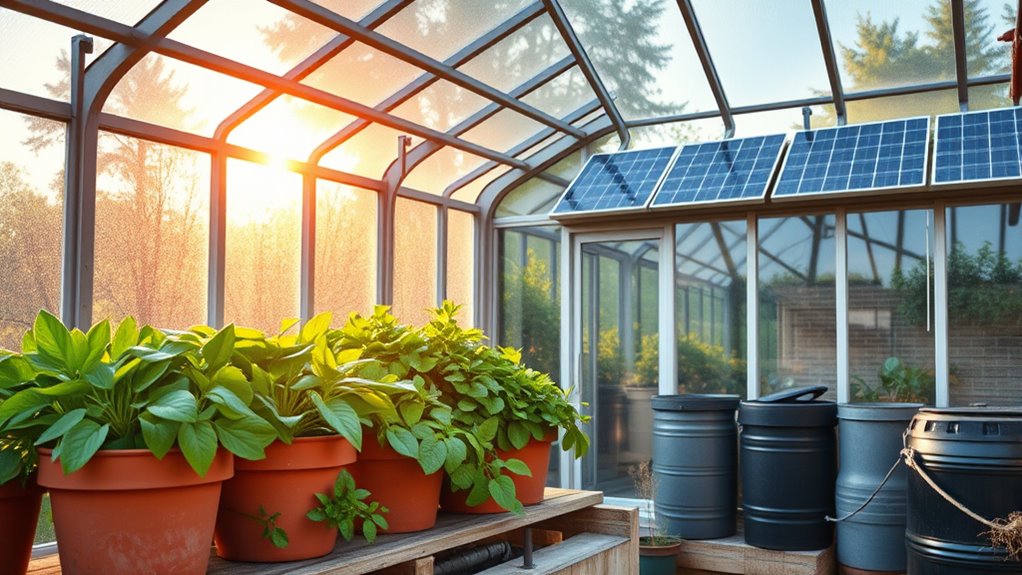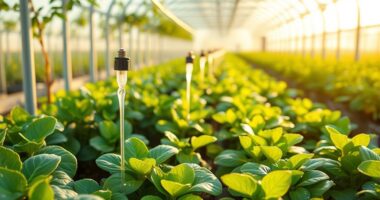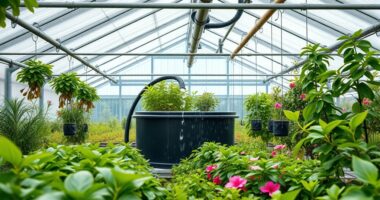To reduce your greenhouse’s carbon footprint, start by harnessing renewable energy like solar panels and wind turbines to cut reliance on fossil fuels. Improve insulation and natural heating to minimize artificial energy use. Choose eco-friendly materials such as reclaimed wood and biodegradable plastics. Adopt water-saving techniques like rainwater harvesting and recycling. Ultimately, monitor your energy and water systems to identify areas for efficiency. Keep exploring how these practices can help you create a greener, more sustainable space.
Key Takeaways
- Incorporate renewable energy sources like solar panels and wind turbines to power greenhouse operations sustainably.
- Use proper insulation and natural heating techniques to minimize artificial energy use and reduce carbon emissions.
- Choose eco-friendly, recycled, and biodegradable materials for greenhouse construction to lower environmental impact.
- Implement water conservation strategies such as rainwater harvesting and greywater recycling to reduce resource depletion.
- Utilize smart monitoring systems and energy-efficient appliances to optimize energy use and decrease carbon footprint.
Harnessing Renewable Energy Sources for Greenhouse Operations
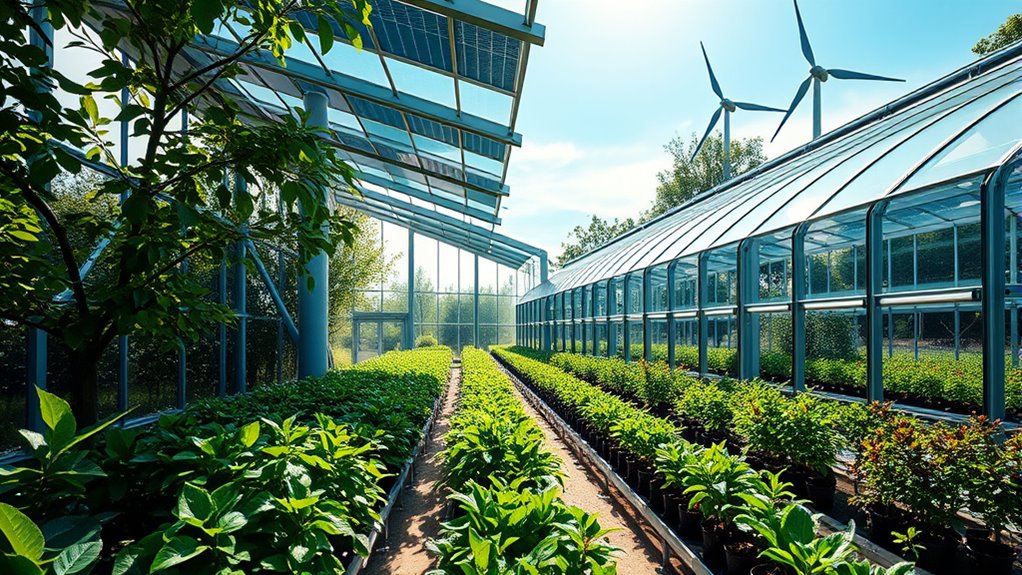
Have you considered how renewable energy can transform your greenhouse operations? Integrating solar panels is a smart move, providing clean, renewable power to run your systems efficiently. Solar panel integration allows you to generate electricity on-site, reducing reliance on fossil fuels and lowering your carbon footprint. Additionally, choosing the appropriate solar energy graphs for your energy planning can help you optimize your system’s performance. Employing energy-efficient technologies can further enhance your sustainability efforts and reduce overall energy consumption. Incorporating solar-powered irrigation systems can help maintain optimal growing conditions and conserve water resources. Installing sustainable plant management practices can improve your crop yield while minimizing environmental impact. Wind turbine installation is another excellent option, especially if your location has steady wind patterns. Installing a small wind turbine can supplement your energy needs, further decreasing your environmental impact. Both options offer long-term savings and energy independence.
Improving Insulation and Natural Heating Techniques
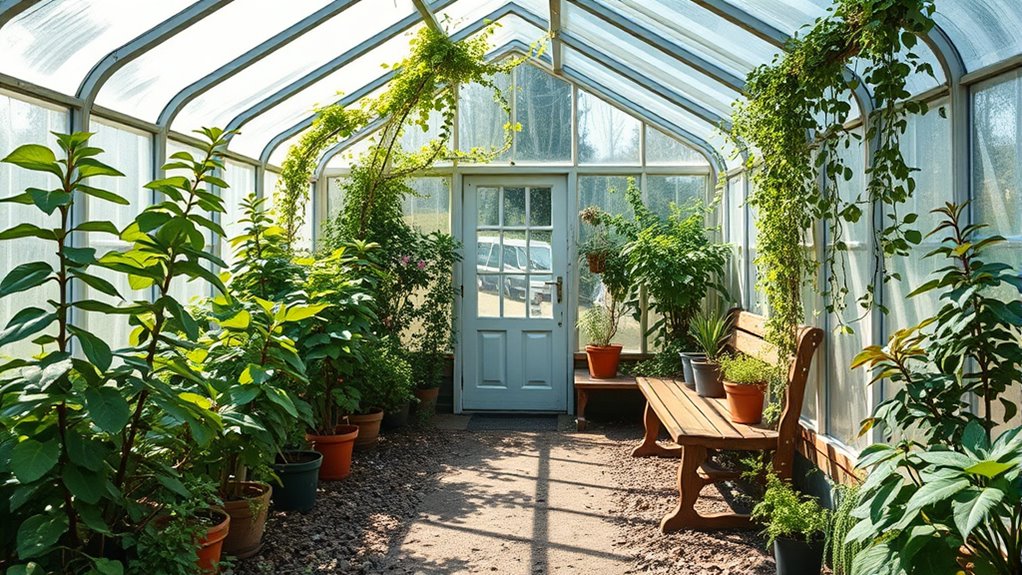
Improving insulation and utilizing natural heating techniques can substantially reduce your greenhouse’s energy consumption. Proper insulation keeps heat inside, minimizing the need for artificial heating. Ensuring your wood stove meets safety standards and is properly installed can also contribute to energy efficiency by reducing heat loss and preventing hazards. Natural heating methods harness the sun’s energy, reducing reliance on power sources. To optimize your setup, consider these strategies:
- Seal gaps and cracks to enhance insulation and prevent heat loss
- Use double-glazed or insulated panels for walls and roofs
- Incorporate thermal mass, like water barrels or stone, to store heat during the day and release it at night
- Maximize sunlight exposure with strategic placement and reflective surfaces
- Understanding insulation techniques can further improve heat retention and efficiency in your greenhouse. For example, selecting durable materials suited for outdoor environments ensures long-term performance. Additionally, implementing energy-efficient design principles can amplify the benefits of your insulation efforts, leading to greater energy savings. Proper ventilation also plays a key role in maintaining optimal temperatures and preventing overheating.
Incorporating Sustainable Materials and Eco-Friendly Practices
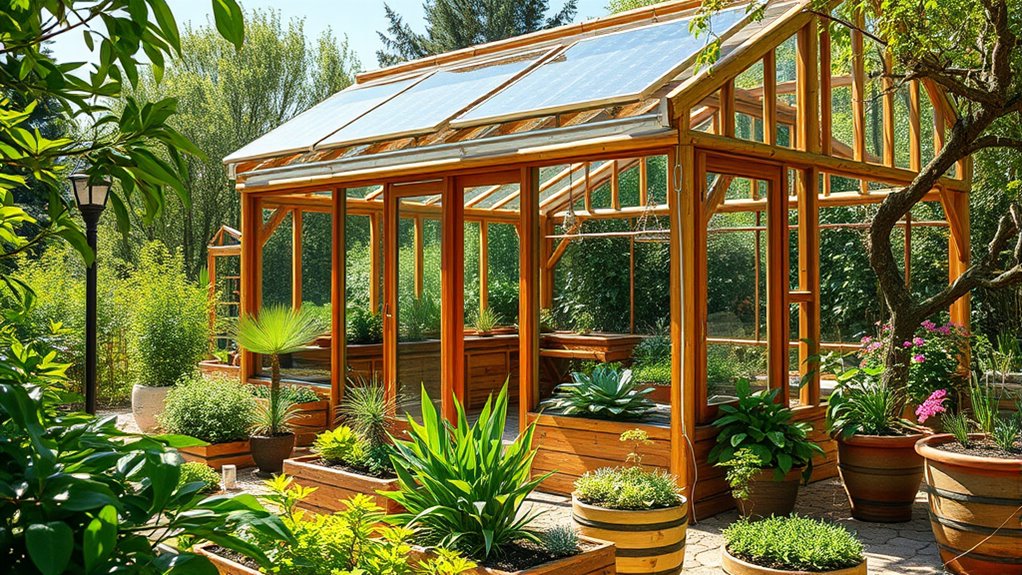
Building on the benefits of natural heating techniques and proper insulation, choosing sustainable materials and eco-friendly practices further reduces your greenhouse’s environmental impact. Opt for biodegradable plastics for plant containers to minimize plastic waste. Use compostable plant pots made from materials like rice husks or coconut coir, which break down naturally, enriching your soil instead of polluting landfills. Incorporate recycled or reclaimed wood for framing or shelving, reducing demand for virgin resources. Additionally, select non-toxic, organic paints and finishes to prevent chemical runoff. Here’s a quick comparison:
| Material Type | Environmental Benefit |
|---|---|
| Biodegradable plastics | Breaks down naturally, reduces pollution |
| Compostable plant pots | Decompose into soil, no landfill waste |
| Reclaimed wood | Saves trees, utilizes existing materials |
| Organic paints | Non-toxic, eco-friendly finishes |
| Recycled metals | Reduces mining impact, conserves resources |
Implementing Water Conservation and Recycling Strategies
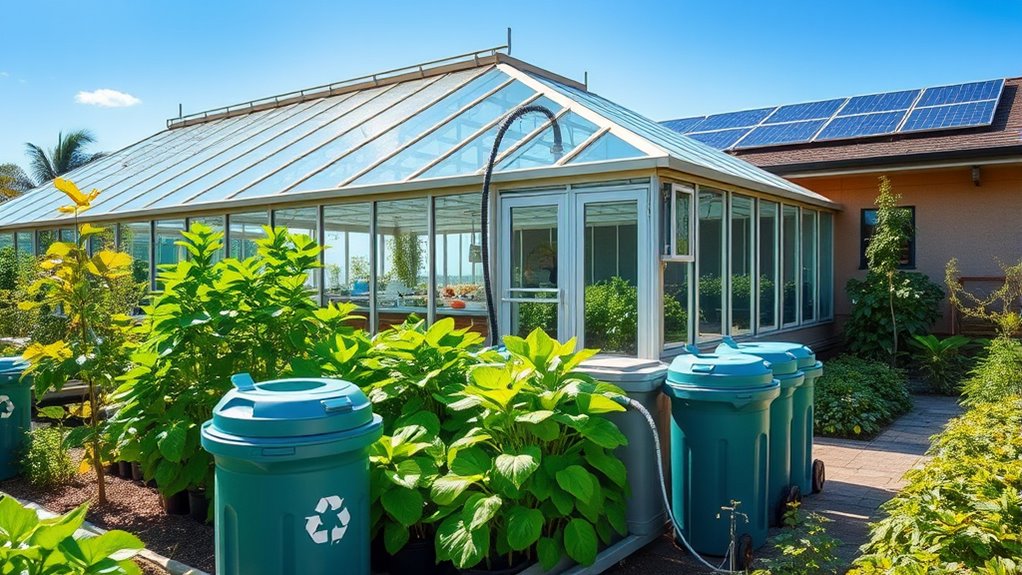
Implementing water conservation and recycling strategies is essential for reducing your greenhouse’s environmental footprint. You can start by collecting rainwater through rainwater harvesting systems, which provide a sustainable water source for irrigation and cleaning.
Next, consider greywater recycling to reuse water from sinks, showers, and laundry for non-potable needs, cutting down on fresh water use. Here are four effective strategies:
- Install rainwater harvesting systems to capture and store rainwater.
- Set up greywater recycling systems for reuse in irrigation.
- Fix leaks promptly to prevent water wastage.
- Use drought-tolerant plants to minimize watering needs.
Additionally, integrating water-efficient technologies can further optimize water use and reduce waste. Implementing sustainable water practices not only conserves water but also promotes an eco-friendly approach to greenhouse management. Incorporating water conservation techniques can lead to significant reductions in water consumption, helping to preserve vital resources for future generations. Employing water management strategies can enhance overall efficiency and sustainability of water resources.
Research shows that using water-saving devices can significantly decrease water usage in greenhouse operations. These measures help conserve water, lower utility costs, and reduce your greenhouse’s overall impact on the environment.
Monitoring and Optimizing Energy Use for Efficiency

To effectively reduce your greenhouse’s energy footprint, monitoring and optimizing your energy use is essential. Keep a close eye on your energy consumption with smart meters or energy management systems. This helps you identify high-usage periods and areas where efficiency strategies can make the biggest impact. Incorporating AI-driven solutions can further enhance your ability to analyze data and automate energy-saving actions. Regularly review your data to spot patterns and adjust your operations accordingly. Implement automation where possible, like sensors that turn off lights or equipment when not in use. Upgrading to energy-efficient appliances and lighting also cuts unnecessary consumption. Additionally, creating a dedicated work environment within your greenhouse can help in maintaining consistent energy use and simplifying monitoring efforts. Embracing powerful persuasive words in your communication can motivate team members to adhere to energy-saving practices. Understanding juice detox side effects and benefits can also inspire sustainable practices that support overall health and eco-friendliness. When combined with energy-efficient practices, these measures can significantly lower your overall energy consumption.
Frequently Asked Questions
How Does a Greenhouse Impact Local Biodiversity?
A greenhouse can impact local biodiversity by supporting native species and aiding habitat preservation. When you use a greenhouse thoughtfully, you create a controlled environment that helps protect local plants and animals from threats like invasive species.
This encourages the growth of native species, maintaining ecological balance. By focusing on habitat preservation, your greenhouse efforts can foster a healthier, more resilient local ecosystem, benefiting biodiversity in your area.
Can Small-Scale Greenhouses Significantly Reduce Carbon Emissions?
Did you know small-scale greenhouses can cut carbon emissions by up to 30%? You can boost solar efficiency by optimizing sunlight exposure, making your greenhouse more eco-friendly.
Plus, cultivating diverse crops reduces reliance on fossil fuels and chemicals, further lowering your carbon footprint.
What Are the Initial Costs of Transitioning to Eco-Friendly Greenhouse Systems?
When considering shifting to eco-friendly greenhouse systems, you should conduct a thorough cost analysis to understand the initial expenses.
The investment benefits include energy savings, sustainable materials, and long-term efficiency.
You might face higher upfront costs for solar panels, insulation, and eco-friendly automation.
However, these investments can pay off over time through reduced utility bills and environmental impact, making it a smart, sustainable choice for your greenhouse operation.
How Do Greenhouse Operations Influence Local Water Tables?
When it rains cats and dogs, it’s easy to forget how your greenhouse operations can affect local water tables. You might unknowingly cause water table depletion by overusing groundwater or contribute to groundwater contamination through runoff containing fertilizers or chemicals.
These practices can harm nearby ecosystems and reduce water availability. To keep things in balance, you need to manage water carefully, ensuring sustainable use and preventing pollution.
Are There Government Incentives for Sustainable Greenhouse Practices?
You’ll find that many governments offer policy incentives and tax credits to support sustainable greenhouse practices. These incentives aim to encourage eco-friendly techniques like energy-efficient systems, water conservation, and renewable energy use.
Conclusion
By embracing renewable energy, natural heating, sustainable materials, and water-saving practices, you’re planting seeds for a greener future. Your greenhouse becomes a living proof to harmony with the earth, a sanctuary where growth and sustainability intertwine like a delicate dance. Every effort you make is a brushstroke on the canvas of our planet’s health, turning your greenhouse into a beacon of hope and a thriving oasis in a world craving change.
